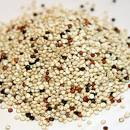I know, I know, the posting has slowed down here. But in my own defense, it is the holiday season and things are a bit crazy here. I am busy baking, but no new recipes yet. However, I have tweaked a few of my older ones, so it might be worth a look if you’re planning on trying any of them this holiday season.
However, I did recently try this nifty little recipe for Gingerbread cookies. I used to make the BEST gingerbread cookies (Cook’s magazine has the gold standard – if you eat butter, gluten, and sugar you simply must try their recipe). Unfortunately, I can no longer eat them. But, there’s no reason to give up; all is not lost, I am sure.
Since I don’t have a whole lot of time to experiment lately, I searched online for a recipe that I thought might work. And I found one at The Vegan Chef. The link to the webpage is on the sidebar to your right.
The flour mixture that this recipe uses is bang on. It provides plenty of mouth-feel/texture, which I like, but doesn’t end up being overly grain-y or nutty. It’s a perfect complement to the strong flavours of the cookie.
Since it is the holiday season, and I only make gingerbread for the holidays, I decided not to play around with the sugars in this recipe. It calls for sucanat and molasses.
The sucanat is great, because it adds to the depth of flavour of the cookies. It also helps to hold the cookie together, and make it puff up. There’s only 1 1/2 cups of sucanat to 5 cups of flour, so, really, it’s not that terrible for you, once a year.
It is difficult to omit the molasses from gingerbread cookies. Molasses is the key to depth of flavour and complexity. There’s really not a lot of it in this recipe (only 1/3 cup). There probably are ways to omit this, but it’s such a small amount that I wouldn’t recommend it. And don’t, for the love of (whoever you want), use blackstrap molasses! I made that mistake on another recipe earlier this year. Blackstrap is very bitter, and basically useless for baking. Use Fancy Molasses. Save yourself the heartache and learn from my mistakes.
One way I find that these cookies are a little bit lacking is in the ginger department. Adding a couple of teaspoons of freshly grated ginger should fix that right up! You can also used freshly grated nutmeg, if you have it on hand. I would recommend keeping the proportions the same, though.
When I make these next year, I will likely play around a bit with the flavours, as my goal will be to replicate the cookies that I made with the Cook’s Magazine recipe.
The cookies do seem to dry out rather quickly. I know this is often a problem with gluten-free cookies. My best advice is to keep them in the freezer, and simply take out as many as you think you might need each morning. They don’t take long to thaw – the lack of dairy really helps in this regard.
Without further ado, here is the recipe from The Vegan Chef –
2 cups brown rice flour
1 1/2 cups arrowroot flour, plus extra for rolling out cookies
1 1/2 cups amaranth flour
2 tblsp baking powder
2 tsp baking soda
2 tblsp cinnamon
1 tsp ground ginger
1 tsp salt
1/2 tsp ground nutmeg
1/2 tsp ground cloves
1 1/2 cups Sucanat, or brown sugar if you prefer
1/2 cup applesauce
1/3 cup safflower oil (Canola is fine, too)
1/3 cup molasses
2 tblsp vanilla
In a small bowl, stir together the brown rice flour, arrowroot, amaranth flour, baking powder, baking soda, cinnamon, ginger, salt, nutmeg, and cloves. Set aside.
In a medium bowl, place the remaining ingredients and stir to combine. Add the dry ingredients to the wet ingredients and stir well to combine.
Cover the bowl, place in the refrigerator, and chill for 1 hour or more.
Oil cookie sheets (2 or more) and set aside.
Sprinkle a little arrowroot over a work surface (instead of the arrowroot, I worked on wax paper, and changed the paper after every second batch. Parchment paper would work equally well, if not better. It’s a bit easier this way).
Divide the chilled dough into quarters. Work with only one quarter of dough at a time. Keep the remaining dough covered and chilled (this is an extremely important point; the warmer the dough becomes, the stickier and more difficult it is to work with – keep it cold!)
Working in batches, roll out the quarter of dough to 1/4 – 1/2 inch thickness. (I find that 1/2 – 3/4 inch is better, especially if you intend to ice the cookies). Cut into desired shapes with cookie cutters.
Carefully (very carefully – it`s easier to do if the dough is a bit on the thick side), transfer the cut cookies to the prepared cookie sheet.
Bake the cookies at 350 degrees for 6 minutes. The cookies will feel slightly soft to the touch when you remove them from the oven. Allow the cookies to cool on racks for 3 minutes before you remove them from the cookie sheets (all baked goods continue to bake as long as they are left in their pan or on their tray). After 3 minutes, remove from tray and place on rack directly to cool.
Repeat until all the dough is finished.
I am having my niece over on the weekend, and she is going to help me decorate the cookies. I will be sure to take a photo of them for the blog!!

P.S. – it`s now possible to subscribe to this blog – visit the sidebar on the right to do so!
Read Full Post »





